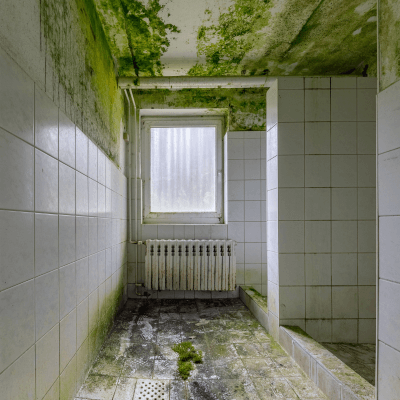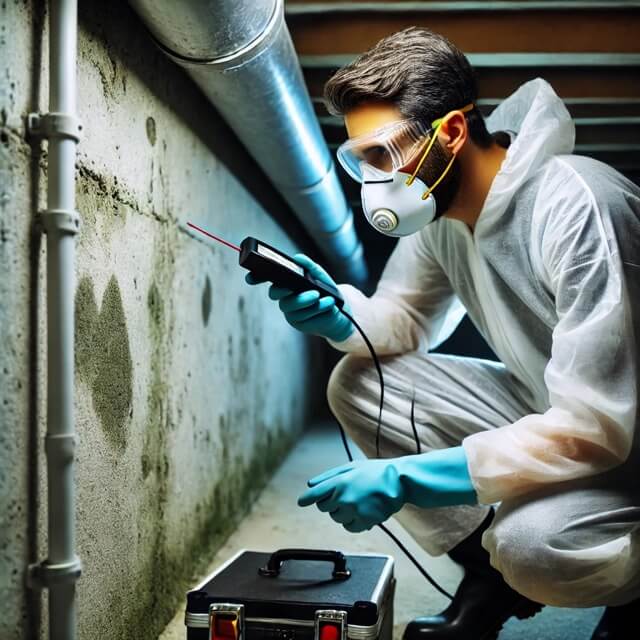If you’re noticing signs of mold—whether it’s visible growth, persistent musty odors, or allergy-like symptoms—you might be considering your options. Maybe you’re thinking about using a DIY mold test kit, or you’ve considered hiring a remediation company for a quick check. However, these approaches may not provide the full picture. At Howard Environmental, we offer a more thorough, professional inspection. In this post, we’ll break down the factors that affect mold inspection cost and explain why investing in a detailed inspection can save you in the long run.
Now, let’s explore the key considerations and what you can expect.
What is a Mold Inspection?

At Howard Environmental, we perform thorough mold inspections to assess areas prone to moisture and identify potential mold growth. Our inspectors check visible spaces, like walls and ceilings, as well as hidden areas like crawl spaces and basements. We take samples from air or surfaces to detect mold spores that may not be immediately visible, ensuring you get a comprehensive assessment of your home.
Mold Inspection vs. Testing vs. Remediation
- Inspection Process: A mold inspection is an initial evaluation to determine if mold is present. We use specialized equipment, like moisture meters and infrared cameras, to locate mold hotspots.
- Testing Methods: Mold testing involves collecting samples (e.g., air, swab, or HVAC) to measure the type and quantity of mold present. Lab analysis determines the type of mold and its concentration in your home.
- What Happens During Remediation?: If testing confirms mold, remediation involves safely removing the mold and addressing the moisture issues that caused it. A remediation company like All Nation Restoration, will clean, disinfect, and restore affected areas.
To better understand the differences between mold inspection and mold testing, check out our detailed post on Mold Inspection vs Testing.
The Type of Mold Can Affect Cost
How Mold Type Affects the Inspection Cost
Certain molds, like black mold or Stachybotrys, pose greater health risks, requiring additional safety measures and testing. For example, if we suspect toxic mold in your home, we may recommend additional air or surface sampling, which can increase costs. Molds that are more easily spread, like Aspergillus, may also demand more extensive inspections, especially in areas like HVAC systems or poorly ventilated spaces.

Common Mold Types Found in Central Texas
- Black Mold (Stachybotrys): A toxic mold that thrives in wet, cellulose-rich environments (like drywall and wood). It often requires more thorough testing and careful remediation, which can increase inspection costs.
- Aspergillus: Frequently found in HVAC systems, this mold type can spread quickly in poorly ventilated areas.
- Cladosporium: Typically found in outdoor environments but can enter homes through windows, making inspections more complex if it invades multiple areas.
- Penicillium: Often found in water-damaged buildings, this mold can spread to carpets, insulation, and furniture.
Austin’s humid environment can worsen allergies due to mold. Learn more about the connection in our article on Austin Allergies and Mold.
What Other Factors Affect the Cost of Mold Inspections?

Size of Property
Larger homes require more time to inspect, more samples, and more comprehensive testing. Whether you’re in a compact house in the city of Austin or a sprawling property in Leander, the size of your home can influence the overall cost of the inspection.
Accessibility of Mold Growth
Mold in hard-to-reach places, like behind walls, in crawl spaces, or attics, takes more time and effort to inspect. Homes that have complex layouts might require specialized tools to access these hidden spots.
Type of Test Required (Swab, Air, HVAC, Culture)
- Swab Testing: Ideal for visible mold, this method is relatively simple and cost-effective.
- Air Testing: Detects airborne spores, useful when mold is suspected but not visible. Air testing tends to be more expensive than swab testing.
- HVAC Testing: Mold can thrive in your ventilation system, and testing the HVAC system adds complexity to the inspection.
When Should You Get a Mold Inspection?
Signs You Need an Inspection
- Visible Mold Growth: Dark spots or discoloration on walls or ceilings are common signs of mold.
- Musty Odor: A persistent, musty smell could indicate hidden mold, even if it’s not visible.
- Unexplained Health Symptoms: If you’re experiencing respiratory issues or allergic reactions without an apparent cause, mold could be the culprit.
- Wondering how to catch mold early? Read our guide on Ways to Check for Mold Before It’s Too Late.
Environmental Triggers in Austin (Humidity, Flooding, etc.)
Austin’s high humidity levels, particularly in the summer, can create ideal conditions for mold growth. Seasonal flooding in areas like Georgetown and Pflugerville can also lead to rapid mold formation if not addressed quickly.
Mold Inspection vs. DIY Mold Testing

Pros and Cons of DIY Mold Test Kits
- Accuracy: DIY kits are often less reliable than professional testing. They may miss hidden mold or fail to provide accurate readings.
- Cost: While cheaper upfront, DIY kits might lead to higher costs if mold goes undetected and spreads.
- When to Use a Professional Instead: If you suspect widespread mold or are concerned about your health, it’s best to call in professionals like us to ensure accurate results and comprehensive remediation.
What to Expect During a Professional Mold Inspection
Steps of the Process
We start with a thorough visual inspection, using moisture meters and infrared technology to identify problem areas. Then, we collect samples (air, swab, or both) and send them to a certified lab for analysis. After testing, we provide a detailed report with recommendations on next steps.
Common Tools and Techniques Used by Professionals
We use advanced tools like infrared cameras to detect hidden moisture, moisture meters to gauge water levels in materials, and air sampling devices to assess airborne mold spores.
Timeframes for Results
Once we collect samples, results are typically available within 3-5 days. We also offer expedited testing for urgent cases.
How to Choose the Right Mold Testing Professional in Austin
Questions to Ask Before Hiring
- What types of testing do you offer?
- How detailed is your final report?
- Will you guide us through next steps if mold is found?
What Certifications to Look For
Look for certifications from NORMI (National Organization of Remediators and Mold Inspectors) or similar organizations, ensuring you’re working with qualified experts.
Importance of Local Knowledge and Expertise in Austin’s Climate
Our team at Howard Environmental knows Austin’s unique climate challenges, from high humidity to seasonal flooding, allowing us to provide better, more localized service to homes in Round Rock, Lakeway, and beyond.
Frequently Asked Questions
How much does a mold inspection cost in Austin?
The cost of a mold inspection can vary widely depending on who you hire and the level of thoroughness you need. Many remediation companies offer basic inspections, but these often prioritize the quickest path to remediation rather than a detailed assessment. At Howard Environmental, we take a more comprehensive approach. Our inspections go beyond surface-level detection by utilizing advanced testing methods to uncover hidden mold. Because we focus on delivering accurate, in-depth results, the cost can vary based on the specific needs of your property.
How can I prevent mold after a flood?
Act quickly to dry your home, use dehumidifiers, and remove any wet materials that might encourage mold growth.
How dangerous is black mold in Austin homes?
Black mold can cause severe respiratory issues, especially in sensitive individuals. If you suspect black mold, it’s important to address it immediately.
What happens after a positive mold test?
We’ll guide you through the remediation process, which includes safe removal of mold and repairing any moisture problems to prevent recurrence. If you’ve received a positive mold test result, here are Your Essential Next Steps to ensure your home is safe.
Book a Mold Inspection Today

Why Choose Us?
- Local Austin Expertise: We’ve spent years working in the Austin area, understanding its specific mold challenges and helping homeowners in neighborhoods from Round Rock to Cedar Park.
- Fast, Reliable Service: We know that mold problems can’t wait, which is why we offer quick scheduling and fast results so you can get the answers you need.
- Competitive Pricing: Our rates are competitive for the Austin area, and we strive to provide the best value for your mold inspection needs.
How to Schedule Your Inspection
If you’re concerned about mold in your home, don’t wait. Contact Howard Environmental today by phone at 737-285-4370 or through our website to schedule your inspection. Let us help you protect your home and health.

